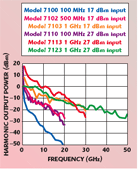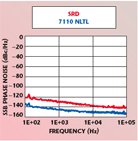
Picosecond Pulse Labs (PSPL) has introduced a new line of comb generators based on monolithic GaAs nonlinear transmission line (NLTL) circuits. The products are known as PSPL’s Low Phase Noise (LPN) Comb Generator product line.
The most commonly used semiconductor device for comb generation has historically been the step recovery diode (SRD). While SRDs have proven very useful in this application, they do have limitations, most prominently the introduction of undesired phase noise and a very limited range of input frequency and power. This new family of comb generators utilizes a different circuit to generate harmonics, a device called a nonlinear transmission line (NLTL). NLTLs employ a completely different physical mechanism for frequency multiplication. The significant technical advantages of NLTL-based comb generators relative to SRD-based comb generators include:
-
Low Phase Noise – better phase noise performance improves overall multiplier module performance. The poor phase noise performance of SRD comb generators often limits multiplier phase noise performance.
-
Wide Range of Input Frequency – flexibility of input frequency allows changes in input frequency or a single device to be used in multiple applications.
-
Low Input Power – relaxes power requirements on amplifiers. This simplifies multiplier design by reducing supply voltages and improving amplifier performance.
-
High Power in High Frequency Harmonics – NLTLs generate faster transitions that have more frequency content, producing more power in higher frequency harmonics. NLTLs also enable higher frequency inputs, increasing the power in each harmonic and increasing harmonic spacing, which simplifies filter design. This allows the use of multiplier-based frequency sources at higher frequencies than was previously possible with SRD-based comb generators.


The LPN Comb Generators cover inputs ranging from 80 MHz to 2 GHz and outputs to 50 GHz. Table 1 lists the various LPN Comb Generator models and their input/output characteristics.
The LPN Comb Generator product line currently has three major sub-groupings:
-
Low Input Power (models 7100, 7102, 7103) – designed to operate with less input power.
-
High Output Power (models 7110, 7112, 7113) – designed to operate with higher input power (comparable to SRD-based comb generators) to offer maximum output harmonic levels and a “drop-in” solution to replace SRD comb generators and improve phase noise performance.
-
Extended Harmonic Frequency Range (models 7123, 7124) – designed to produce more high frequency harmonic content.

Each of these models is offered in small coaxial, surface-mount, or drop-in style packages. Coaxial packages provide easy prototyping, testing and characterization, while surface-mount and drop-in style packages are well suited to volume production assembly.
The output harmonic power versus frequency for six of the LPN Comb Generator models is shown in Figure 1. Each of the models is being driven at its nominal input frequency and power. The same data plotted as conversion loss versus harmonic number shows that each of the models has a comparable conversion loss for a given harmonic, with some modest differences.
Applications
The primary application for comb generators is as frequency multipliers to produce a high frequency phase-locked to the input. A typical example of this would be to use a 100 MHz crystal reference oscillator and multiply it up to a higher frequency for driving the LO of a mixer in a receiver downconverter. In some cases this multiplication may consist of multiple stages, such as multiplying from 100 to 500 MHz, then from 500 MHz to 10 to 12 GHz for applications such as X-band radar.
In a multiplier application, the output of the oscillator is typically fed to an amplifier (to obtain the proper drive level for the comb generator). This signal is then fed to the comb generator that generates harmonics of the input signal. These harmonics are spaced at intervals of the input signal frequency. The harmonic of interest is then filtered off with a bandpass filter (passes only the harmonic of interest). Finally, the isolated harmonic is amplified to the desired level. An example diagram of a multiplier chain is shown in Figure 2.

SRD vs. NLTL Operation
SRD comb generators create a fast edge and generate harmonics by sweeping stored minority carriers from the depletion region during the transition from forward to reverse bias with large reverse recovery currents. As a result, SRDs are subject to recombination noise as well as shot noise. These processes add timing jitter to the output pulse, which manifests itself in the frequency domain as additional phase noise above the baseline 20logN increase of the ideal frequency multiplier. This can add as much as 15 dBc/Hz to the output phase noise, depending on the quality of the source used. The NLTL is a synthetic transmission line, where Schottky varactor diodes are distributed along a high impedance transmission line, and their lumped capacitance is “absorbed” into the line (see Figure 3).
The capacitance of a reverse biased Schottky diode is nonlinear (voltage dependent) such that the capacitance at low reverse bias is much greater than the capacitance at high reverse bias. As such, a signal propagating on a synthetic transmission line made with varactors experiences a propagation velocity that is voltage dependent. A large step signal that transitions from low to high voltage will be compressed in time as the initial low voltage portion of the step travels down the line slower than the later, higher voltage portion of the step. Consequently, the higher voltage portion of the waveform “catches up” with the lower voltage portion of the step, resulting in “edge compression”, increasing the edge speed of the low-to-high transition. This behavior is similar to an ocean wave getting steeper and steeper as it approaches the shore, when the trough of the wave is slowed by interaction with the ocean floor, while the crest continues at a higher velocity, until the wave “breaks.”

LPN Comb Generator Performance
Since NLTLs are basically passive (albeit nonlinear) majority carrier devices, they do not suffer from recombination and shot noise, and consequently have much better phase noise performance, as illustrated in the comparison residual phase noise plot of NLTL [PSPL Model 7110] and SRD based comb generators shown in Figure 4.
In addition to low phase noise, NLTL-based comb generators also offer several other advantages over narrowband tuned SRD-based comb generators. Typically, SRD-based comb generators have less than a five percent input frequency range and are available only for specific frequencies. SRDs also require a specific amount of input power to effectively drive the harmonic generation process. Since NLTL lines are inherently broadband, they can accommodate well over an octave of input frequency range in a single device and they easily accommodate a broad range of input power (on the order of 10 dB). As an example, see the harmonic power output plots shown in Figure 5 for the LPN model 7100 comb generator operating over a range of input frequencies and input powers.
In addition, since NLTLs have faster transitions, and can be driven at much higher input frequencies than SRD-based comb generators, they have more power in the higher harmonics (see the plot of a LPN model 7123 comb generator vs. a commercial SRD comb generator shown in Figure 6). All of these performance and functional advantages translate into better performance, greater system design flexibility and simpler system architectures.

Picosecond Pulse Labs,
Boulder, CO (303) 443-1249,
www.picosecond.com
